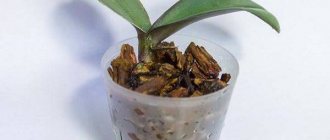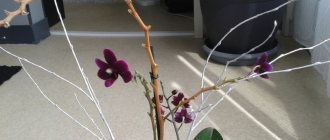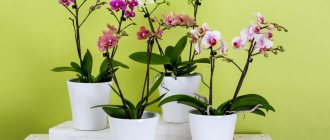The color variety of orchids is impressive, but are there blue orchids? Blue phalaenopsis are very common on the shelves of shopping centers. The unusual coloring attracts attention and fascinates. To an ignorant person, such plants seem like a real miracle of nature. In fact, this is a clever marketing ploy by the manufacturer.
Special dyes give them their unusual color. In the absence of proper care, such plants are most often doomed to slow death from poisoning. So, how to preserve blue phalaenopsis?
The history of the blue orchid
Blue orchids were first presented in 2011, at an exhibition in Florida, by an agricultural company called Silver Vase. After 3 months, one of the participating firms demonstrated its version of the blue flower. After this event, all flower shops began to offer applications for the sale of blue or blue orchids. The Geest Orchideeën company, which was the second to show a blue flower, did not hide the fact that the color was obtained chemically and in subsequent blooms the orchids will be their natural color. The technique used by the representatives has not been disclosed to date, but experienced flower growers have found their own techniques.
Interesting! There is only one conclusion in this situation, the deep blue color of the orchid is not a feature of the variety, but only a desire to attract attention, which is achieved by coloring. In Western countries, such flowers are often used to decorate rooms for celebrations.
Varieties with a blue tint
Despite the fact that deep blue orchids have not yet appeared in nature, there are still species that slightly correspond to this color scheme:
- The Vanda orchid is a variety to highlight. In nature, it can be found in the forests of China or Thailand. Vanda's purple or lilac flowers are covered with white spots. The variety is not very suitable for growing at home because it needs special care. But Vanda has the ability to cross well with other varieties of orchids, which many breeders use for their own purposes. The result is species of orchids with varying intensities of purple color.
- Cattleya is another orchid that is not as demanding of care as Vanda. During flowering, this variety has a very delicate aroma, but also does not have a rich blue or light blue color. Sometimes in stores you can find purple or pink-blue Cattleya.
- Phalaenopsis is the most unpretentious variety of orchids that can most often be found at home. In addition, this particular variety is sold in blue in stores. Phalaenopsis takes root well in homes where there are people with allergies; this plant does not have cloying odors and does not emit pollen.
Attention! All of the above species do not have the blue color we are talking about and in the most ideal version they can only have a bluish tint.
Varieties
There are 15 varieties of the zygopetalum orchid.
Blue Angel has a unique black pepper aroma. This species is considered quite capricious, so it is not recommended for cultivation by beginners. Its petals are white with a lilac-blue border, and the lip itself is slightly darker.
How can you tell if an orchid is colored?
Whether an orchid is painted or not is quite easy to understand if you pay attention to a number of signs:
- the stem of a normal orchid is of natural color, without the shades inherent in the flower;
- if a colored mark remains on the skin after touching a flower, it means that orchid paint has been applied to it;
- the soil in which the plant grows should also not show signs of coloring, its color is completely natural.
Important! If you are lucky enough to buy a blue orchid, you should know that the initial care for it is slightly different, because the plant was subject to chemical and mechanical intervention.
Frequent illnesses
The risk of disease in a painted orchid is much higher. At the slightest sign of illness, treatment begins immediately. A weakened plant has much less chance of survival. Below is a table with the symptoms of major diseases and methods of treating them.
Table - Orchid diseases and methods of their treatment
| Disease | Signs | Treatment |
| Bacterial spot | - Appearance of spots; - yellow leaves; - darkening of leaves; — softening of leaves; - appearance of ulcers | — Removal of affected leaves; - fungicide treatment |
| Powdery mildew | — White coating; - drying of damaged parts | — Spraying with colloidal sulfur; — spraying with “Skor” or “Topsin-M” preparations |
| Sooty fungus | — Black plaque; - weakening and death of the plant | — Treatment with drugs “Mikosan”, “Ridomil”, “Topsin-M” |
| Rot | — Softening of roots and leaves; - appearance of rot | — Trimming rotten parts; — transplantation with changing the container and substrate; - fungicide treatment |
How to get blue orchid flowers?
There are two ways that help give blue tones to a white flower. The most humane of them is coloring through water that is watered on the plant. This method has the disadvantage that when watering stops, the flower returns to its natural color. In addition, the stem of the orchid also becomes somewhat blue during watering. To obtain the desired effect, it is enough to dissolve the dye in water in the required concentration; the more dye, the richer the color of the flowers.
Important! It should be remembered that the use of dyes is harmful to the plant.
A blue orchid at home can be obtained after coloring injections. The injection is usually given in the area of the peduncle; it should be carried out as least traumatically as possible. You need to take a syringe with the thinnest needle and fill it with liquid with dye.
For mixing, it is better to take warm, settled water, and the injection site and the needle itself must be disinfected. If there is no opportunity or desire to buy chemical coloring preparations that are available in flower shops, you can use food coloring.
Important! It is better to carry out coloring injections by piercing the peduncle; introducing the drug into the roots is the most traumatic for the orchid.
It is necessary to understand that any of the methods is potentially dangerous for the orchid and can lead to diseases and even death of the plant. After applying the coloring material, the flower needs additional care.
Are there really no blue phalaenopsis in nature?
There is no such bright blue color as painted ones. There are pale blue, blue with a lilac tint, white with a blue-gray tint. Such shades are very rare for phalaenopsis. These are mainly species plants with small flowers and primary hybrids based on them.
For example, natural blue forms:
- Phalaenopsis violacea coerulea (photo 10)
- Doritis pulcherrima coerulea (photo 11)
- Phalaenopsis equestris cyanochilus
Photo 10. Phalaenopsis violacea coerulea
Photo 11. Doritis pulcherrima coerulea
And some famous hybrids:
- Doritaenopsis Peter "Blue Sky" (photo 12)
- Doritaenopsis Purple Martin "KS" (photo 13)
- Doritaenopsis Kenneth Schubert “Blue Angel” (photo 14)
- Doritaenopsis Siam Treasure “Blue” (photo 15)
Photo 12. Doritaenopsis Peter “Blue Sky”
Photo 13. Doritaenopsis Purple Martin "KS"
Photo 14. Doritaenopsis Kenneth Schubert “Blue Angel”
Photo 15. Doritaenopsis Siam Treasure “Blue”
Although these orchids have small flowers, the shades are the most natural, without coloring.
Now you know everything about blue phalaenopsis. Decide for yourself which one will become your pet.
Author: Irina Baltaga Updated: April 14, 2021
- All about orchids
Further actions
If you bought a painted orchid at a flower shop, you should not rush to replant it. Depending on how long ago the procedure was carried out, the flower needs a period of rest and the opportunity to adapt to new conditions.
If you notice a deterioration in the condition of the orchid after purchase, you need to take some measures:
- Carefully remove the plant from the pot and rinse the roots under running water.
- Trying to find traces of injections, if they are found in the root area, it will be difficult to save the orchid.
- Usually the place where the injection was made forms rot; it is advisable to cut off this place and apply crushed coal or ash.
- After inspection, transplant the orchid into new soil, which consists of moss and bark.
- In the future, if the orchid begins to recover, care for it is standard, intended for the variety.
Flower in the house: care features
Caring for painted phalaenopsis is no different from usual. Success in breeding is based on three pillars: watering as the soil dries out, regular fertilizing at least once a month, and spraying the leaves.
However, there are nuances that are worth paying attention to: if the coloring was done through irrigation, then you need to constantly add dye to the water to maintain the color.
Watering
Soft water is used for irrigation; if it is tap water, it must be allowed to settle. In summer, watering is done once every four days, in winter - once every two weeks.
You can water in three ways: by immersing the pots in a basin for half an hour or with a warm shower from a watering can.
Top dressing
You can start fertilizing an orchid only after adaptation to a new place. Fertilizers containing succinic acid are preferred.
Feeding rules:
- It is recommended to fertilize only healthy phalaenopsis;
- You should not apply fertilizers during the flowering period, this will shorten its duration;
- during the dormant period, reduce the amount of fertilizing to once every two weeks;
- Spills of fertilizer should be carried out on a damp substrate - this will protect the roots from burns.
Transfer
Frequent transplants are detrimental to the plant. The procedure should be performed no more than once every 2-3 years if necessary, for example, the pot has become small.
Transplant stages:
- The plant must be removed from the container and cleared of soil.
- Carefully inspect and remove rotten roots.
- Sprinkle the cut areas with charcoal and leave to dry for a while.
- Plant in fresh soil.
It is necessary to water phalaenopsis as usual a few days after replanting.
Pests and diseases
The most popular orchid diseases that can cause the flower to die are:
- Anthracnose. This is a type of fungus. It manifests itself in the formation of dark spots on the leaves due to high humidity in the room or excessive watering. Treatment involves cutting out the affected areas and burning them with charcoal, as well as reducing the intensity of watering.
- Powdery mildew. With it, the leaves become covered with a whitish coating. Occurs most often due to the presence of the greenhouse effect indoors. It should be eliminated and the orchid should be sprayed with a specialized product.
- Rust. The disease is rare and manifests itself in spot yellowing of leaves. Problem areas are cut out and disinfected.
The most common pests of orchids are thrips, mealybugs, and nematodes. The plant must necessarily be treated with industrial means, for example, Aktara or Fitoverm. If the insects are not exterminated, the flower will disappear.
Lighting
Lighting conditions are very important for any type of orchid. If the pot with the plant is placed on the west side, you can practically eliminate the need for artificial lighting.
The western side of the window prevents direct sunlight from entering the flower.
It is also possible to place an orchid on the south side of the apartment all year round, but on hot days it is necessary to control the soil moisture and add water if necessary. The location of the orchid pot on the windowsill on the north side requires the installation of additional phyto lamps, which will extend the daylight hours.
The orchid blooms best if it is illuminated for 12-16 hours.
Interesting! If there are no purple pigment spots on the inside of the leaf, this indicates that the orchid does not have enough lighting.
Despite its light-loving nature, the sun can be dangerous for orchids during its active period; at this time it is better to hide the plant in the shade. If it is not possible to extend the daylight hours for an orchid, cut it off for the winter and leave it until the lighting increases naturally.
Watering and fertilizing
The watering regime should be adjusted independently, based on the ambient temperature; the faster the moisture evaporates from the pot, the more often it is necessary to add water. In any situation, the humidity level must not be exceeded, as this can cause rotting of the root system.
For many gardeners, the immersion method is convenient, in which the pot along with the plant is lowered into a container filled with water for 30-60 minutes. After the pot is cured, excess moisture is drained through the drainage holes.
If you use watering in the form of bathing the orchid, you need to do this under a weak water set or use a shower. Then let the water drain and remove moisture from the axils of the leaves.
Due to the unusually bright colors, it becomes clear why the blue orchid is so popular. Before you decide to carry out the coloring procedure at home, you should understand that interfering with the natural course of an orchid’s life can be detrimental to its health.











